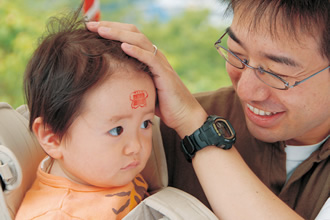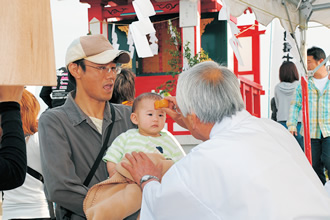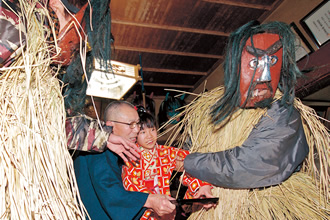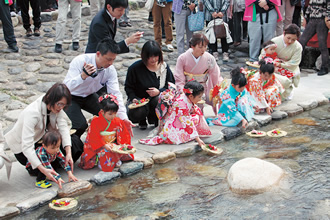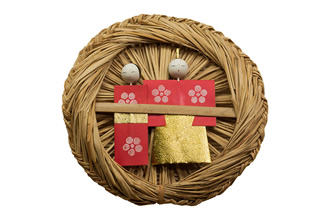niponica is a web magazine that introduces modern Japan to people all over the world.
2018 NO.24
Japanese Festivals Throughout the Year

Festivals for Children
Long ago, when children fell ill more often, many festivals involved children, expressing hopes for good health and growth. Many still happen all over Japan today.
Photos courtesy of Tochigi Prefecture and Local Products Association; City of Ashikaga, Oga City Board of Education, Mochigase Nagashibina Gallery, Kyodo News
A prayer inked on the baby’s forehead
Hatsuyama Festival
A communal expression of hope for the good health and growth of children. Held every year on June 1, the first day of the climbing season, at Ashikaga Fuji Sengen-jinja Shrine in the city of Ashikaga, Tochigi Prefecture, in the northern Kanto region. New-born babies are taken to the shrine, where a bright red stamp is used to make a harmless ink seal on their foreheads.
The shrine’s focus of veneration is Mount Fuji, and the festival’s name, hatsu (first) yama (mountain), implies that this is the first time many of the children have visited this mountain shrine. In ancient times, when many children suffered from the floods, famines and epidemics that occurred, dragons drawn on banners were put up in the wind on the mountain the shrine venerates, and this, so the legend goes, helped protect local children from harm. This is how the festival started. When the ink stamp makes its impression on little foreheads, some kids stay quiet, but some show surprise and make a bit of a ruckus.
Good spirits chase away laziness
Namahage
As the namahage chase away laziness from the kids, family members play at protecting their kids from the namahage.
On New Years’ Eve, in the city of Oga, Akita Prefecture, in the Tohoku region, local youths disguised as demons go from house to house shouting loudly in the local dialect “Are there any kids around here who cry a lot?” or “Does any kid here disobey their parents?” These “demons,” known locally as namahage, wear awesomely large masks and traditional straw mino raincoats, so it is not surprising that the sight scares some children and makes them cry.
The whole point for the people where this custom is observed, however, is that the namahage are actually good spirits come to warn children and adults alike against laziness, and to offer blessings for good health, bring good harvests from the fields and food from the sea and hills, and grant good luck and happiness for the new year. Homes receiving visits from namahage are ready to welcome them cordially with food and saké made from recipes passed down from one generation to the next.
Good health for girls
Nagashi-bina
A festival that expresses the desire for good health and happiness for girls, held in April each year. In Mochigase Town in the city of Tottori, Tottori Prefecture, facing the Sea of Japan, the dolls are floated down a river in a custom called mochigase no nagashi-bina. Paper dolls representing a man and a woman are placed on a round cover made of woven straw, decorated with sprigs of peach blossoms or the like, and then sent on their way down the Sendai River.
Since the custom first developed about 400 years ago, the dolls, made generally from paper, are brushed against a person’s body so that misfortune and bad luck is transferred to the dolls, and then to the river after the dolls float away. Today, girls dressed in their festive best gather on the riverbed on the day of the festival and, together with their sisters and other family members, set the dolls on the flowing water. The scene is quite colorful, just the right setting for a girls’ festival.
Halloween: A fun time for young adults
Halloween, the evening of October 31, is known as a time for children to dress up in frightening costumes and go door to door in their neighborhood. The custom began long ago in Europe to pray for a good autumn harvest and chase away bad spirits. Since around 2010 it has grown in popularity in Japan too, although it is mostly celebrated by people in their 20s and 30s who enjoy “cosplay” —having fun by putting on “costumes” to “play.”
In Tokyo, young people gather in lively parts of the city like Shibuya and Roppongi, dressed as fanciful creatures, perhaps animé characters, strolling along the streets and turning them into a party. Their photos will probably end up on social media, and local clubs and restaurants get into the act to help people enjoy themselves.
Special sales counters at department stores offer costumes, together with makeup sets and accessories. The economic ripple effect from this fad is growing year by year.




